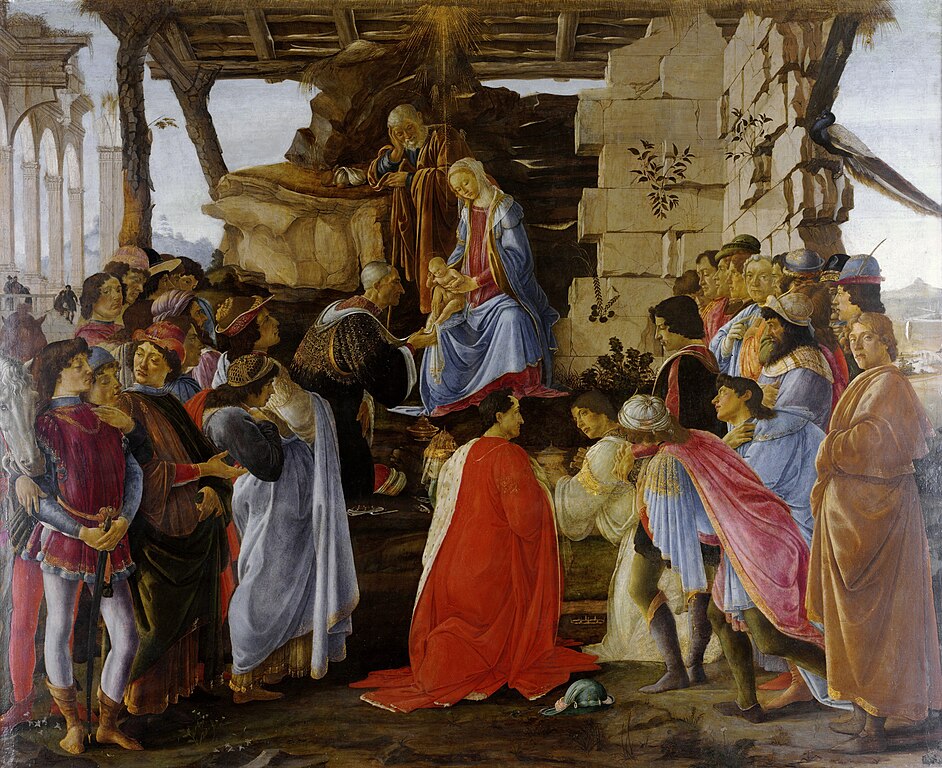
Name: Adoration of the Magi
Artist: Sandro Botticelli
Date Painted: 1475
Period: Renaissance
Dimensions: 111cm (h) x 134cm (w)
Medium / Material: Tempera on Panel
Current Location: Uffizi Gallery, Florence
Introduction
Sandro Botticelli’s “Adoration of the Magi” is a remarkable painting that merges religious subject matter with a rich tapestry of personal, historical, and artistic elements. Created around 1475-1476, this work is housed in the Uffizi Gallery in Florence, Italy. It is one of several renditions of the Adoration theme by Botticelli, but this particular version is especially noted for its inclusion of members of the Medici family, influential patrons of the arts during the Renaissance, as well as a self-portrait of the artist.
Composition and Subject
The painting depicts the biblical story from the Gospel of Matthew, in which the three Magi (or Wise Men) visit the newborn Jesus Christ to offer gifts of gold, frankincense, and myrrh. This scene is a popular subject in Christian art, symbolizing Christ’s recognition not only by the Jews but also by the Gentiles. Botticelli’s composition is dense and carefully arranged, with the figures of the Holy Family at the center, surrounded by the Magi and their retinue, in a semi-circular formation that guides the viewer’s eye towards the infant Jesus.
Symbolism and Representation
One of the most intriguing aspects of Botticelli’s “Adoration of the Magi” is its use of contemporary figures to represent biblical characters. The Magi are portrayed with the features of members of the Medici family: Cosimo de’ Medici, the patriarch of the family, is presented as the oldest of the three Magi, while his sons Piero and Giovanni are depicted as the other two. Lorenzo de’ Medici, the de facto ruler of the Florentine Republic and Botticelli’s patron, is shown as a young man on horseback. This blending of the sacred and the contemporary not only serves as a tribute to the Medici but also reflects the practice of using religious art to assert social and political status.
Botticelli includes a self-portrait in the scene, looking out at the viewer from the far right of the painting. This inclusion is a common feature in Renaissance art, serving both as a signature and as a testament to the artist’s presence at the divine event, symbolically linking the temporal and the eternal.
Artistic Style
“Adoration of the Magi” exemplifies Botticelli’s mastery of line and form. The figures are rendered with elegance and clarity, their graceful postures and expressive gestures imbued with a sense of harmony and serenity. The use of perspective and the careful arrangement of figures demonstrate Botticelli’s skill in creating a cohesive and impactful composition. The detailed depiction of clothing and ornaments, along with the varied expressions of the figures, adds depth and richness to the scene.
The landscape in the background, although not as prominently featured as in other works by Botticelli, provides a serene setting for the divine event, with the ruins possibly symbolizing the old order giving way to the new era ushered in by Christ’s birth.
Cultural and Historical Context
“Adoration of the Magi” reflects the humanist interests of the Renaissance, blending classical, Christian, and contemporary elements. The inclusion of the Medici and other prominent Florentines in a religious scene illustrates the intertwining of religious devotion, art, and political power during the Renaissance. It also highlights the role of art as a medium for personal and familial commemoration and for the negotiation of social status.
Conclusion
Botticelli’s “Adoration of the Magi” is a masterpiece that captures the spirit of the Renaissance through its integration of religious narrative, personal portraiture, and political allegory. It showcases Botticelli’s exceptional talent in composition, his exquisite attention to detail, and his ability to imbue his works with deep symbolic meaning. This painting not only serves as a vivid portrayal of a biblical story but also as a reflection of the cultural, social, and artistic dynamics of 15th-century Florence.